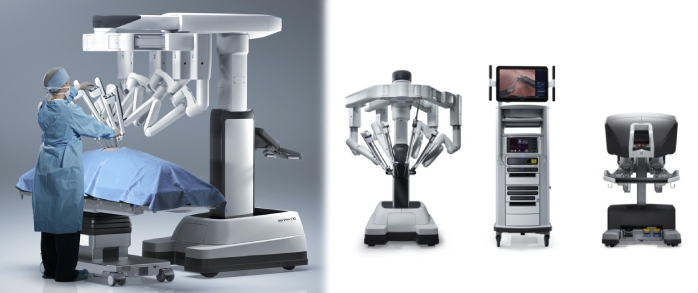Robotic Surgery
O’Connor Hospital is proud to offer robotic-assisted surgery, allowing surgeons to perform more complex minimally invasive surgical procedures with increased precision. The advanced da Vinci® robotic platform is designed to enhance the surgeons’ capabilities in minimally invasive surgery and improve patient experience and surgical outcomes.
How Does the da Vinci® Robot Work?
The da Vinci® Surgical System allows surgeons to operate from a seated position at a console. The console viewer displays 3D images of the surgical area with magnification up to 10x. The robotic arms are used to hold surgical instruments that can retract, cut, cauterize, suture, staple. The hand controls at the console control the camera and instruments with wrist articulation. By providing surgeons with superior vision, enhanced dexterity, greater precision and ergonomic comfort, the robot makes it possible for more surgeons to perform complex minimally invasive procedures safely and effectively.
The robot does not operate autonomously, and the surgeon is in control of all movements during the procedure at all times.
Why Robotic-Assisted Surgery?
Compared to open surgery, robotic surgery offers several benefits to patients, including smaller incisions, less blood loss, a shorter hospital stay, less pain and decrease use of narcotic pain medication, and a faster recovery and return to normal daily activities. In addition, Robotic-assisted surgery enhances the application of minimally invasive surgery beyond laparoscopic surgery, by providing stability of motion, 3D visualization, improved reach, and articulation of instruments.
Setting a Standard of Excellence
O’Connor Hospital achieved SRC accreditation as a Center of Excellence in Robotic Surgery (COERS) in December 2022. It is the first facility to achieve this status. Dr. Thomas Hirai is recognized as a Surgeon of Excellence in Robotic Surgery.
O'Connor Hospital and Dr. Hirai have been recognized for curating a culture of excellence by committing to safety, high-quality surgical care and optimal patient outcomes.
What are the requirements of SRC accreditation?
To achieve accreditation, providers undergo a rigorous, unbiased inspection to ensure they meet nationally and internationally recognized standards of excellence. Unlike some accreditation programs, SRC is not part of a medical society that uses its members to evaluate colleagues. The inspection evaluates treatment pathways and consultative services, equipment used for treatment, patient education and support groups available. The requirements for accreditation programs have been proven to improve outcomes and reduce the time patients spend in the hospital.
What sets SRC-accredited surgeons apart?
Many accreditation programs only accredit the hospital. SRC is unique in accrediting not only the facility where surgeries are performed, but the individual providing the treatment: the surgeon.
SRC accreditation distinguishes O’Connor Hospital and Dr. Hirai from those without accreditation by advancing surgical team leaders in improving care quality and adopting proven clinical approaches to drive best-in-class surgical care.
What does SRC’s gold seal of accreditation mean for patients?
Patients can trust SRC’s gold seal to identify health care providers who deliver excellence in patient safety and care. Look for the seal, expect excellence.
About SRC
Established in 2003, Surgical Review Corporation (SRC) is an internationally recognized, nonprofit, patient safety organization that administers best-in-class accreditation programs for medical professionals, surgeons, hospitals and freestanding outpatient facilities. These programs improve the safety and quality of patient care and lower the overall costs associated with successful treatment.
CONTACT US
PHONE
TRANSPORTATION
Bus Line 59
For bus schedules and more information, please contact Santa Clara VTA Customer Service Call Center: (408) 321-2300 or visit www.vta.org.

